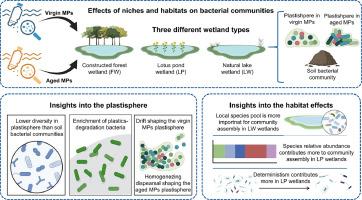Niche vs habitat: Insights of aging microplastics and wetland types on bacterial community assembly
IF 6.3
2区 环境科学与生态学
Q1 ENVIRONMENTAL SCIENCES
引用次数: 0
Abstract
Microorganisms can colonize the surface of microplastics (MPs) to form a distinctive microbiome, known as a “plastisphere” which is regarded as an anthropogenic niche for microbial growth. However, bacterial community assembly in virgin and aging MP plastispheres across different habitats is poorly understood. This study aims to assess the variations in bacterial community assembly across different niches and habitats with an in situ experiment, in which constructed forest wetland (FW), natural lake wetland (LW), and lotus pond wetland (LP) were habitats, and plastispheres of virgin and aging low-density polyethylene (LDPE) MPs, as well as surrounding wetland soils were niches. Significant niche-related differences in bacterial communities were observed, with lower diversity and enrichment of potential plastic-degrading bacteria in the plastisphere than in the soil bacterial communities. Furthermore, habitat-related differences exerted a more pronounced influence on the beta-diversity patterns of the bacterial communities. The linear regression analyses indicated that the local species pool contributed more to bacterial community assembly in the LW wetland, whereas the relative abundance of species was the primary factor in the LP wetland. The null model analysis indicated that plastisphere bacterial communities were predominantly driven by the stochastic process, with a more deterministic assembly observed in the LP wetland and soil bacterial communities. Additionally, the primary ecological process shaping plastisphere communities shifted from drift in the virgin LDPE to homogenising dispersal in the aging LDPE. This study provides new insights into the fate and ecological impacts of MPs in wetlands, thereby facilitating the effective regulations of plastic pollution.

生态位vs栖息地:老化微塑料和湿地类型对细菌群落组装的见解
微生物可以在微塑料(MPs)表面定植,形成一个独特的微生物组,称为“塑料球”,被认为是微生物生长的人为生态位。然而,细菌群落在不同栖息地的原生和老化MP塑料球中的组装情况尚不清楚。本研究以人工森林湿地(FW)、天然湖泊湿地(LW)和荷塘湿地(LP)为生境,原生和老化的低密度聚乙烯(LDPE) MPs塑料球及其周围湿地土壤为生态位,通过原位实验研究不同生态位和生境下细菌群落组合的变化。细菌群落存在显著的生态位相关差异,塑料圈内潜在降解细菌的多样性和富集程度低于土壤细菌群落。此外,与生境相关的差异对细菌群落的β -多样性模式的影响更为明显。线性回归分析表明,本地物种库对低海拔湿地细菌群落聚集的贡献更大,而物种相对丰度是低海拔湿地细菌群落聚集的主要因素。零模型分析表明,塑料圈细菌群落主要受随机过程驱动,LP湿地和土壤细菌群落具有更强的确定性。此外,形成塑性圈群落的主要生态过程从原始LDPE中的漂移转变为老化LDPE中的均匀扩散。本研究为湿地MPs的命运和生态影响提供了新的见解,从而促进了塑料污染的有效调控。
本文章由计算机程序翻译,如有差异,请以英文原文为准。
求助全文
约1分钟内获得全文
求助全文
来源期刊

Journal of Environmental Sciences-china
环境科学-环境科学
CiteScore
13.70
自引率
0.00%
发文量
6354
审稿时长
2.6 months
期刊介绍:
The Journal of Environmental Sciences is an international journal started in 1989. The journal is devoted to publish original, peer-reviewed research papers on main aspects of environmental sciences, such as environmental chemistry, environmental biology, ecology, geosciences and environmental physics. Appropriate subjects include basic and applied research on atmospheric, terrestrial and aquatic environments, pollution control and abatement technology, conservation of natural resources, environmental health and toxicology. Announcements of international environmental science meetings and other recent information are also included.
 求助内容:
求助内容: 应助结果提醒方式:
应助结果提醒方式:


